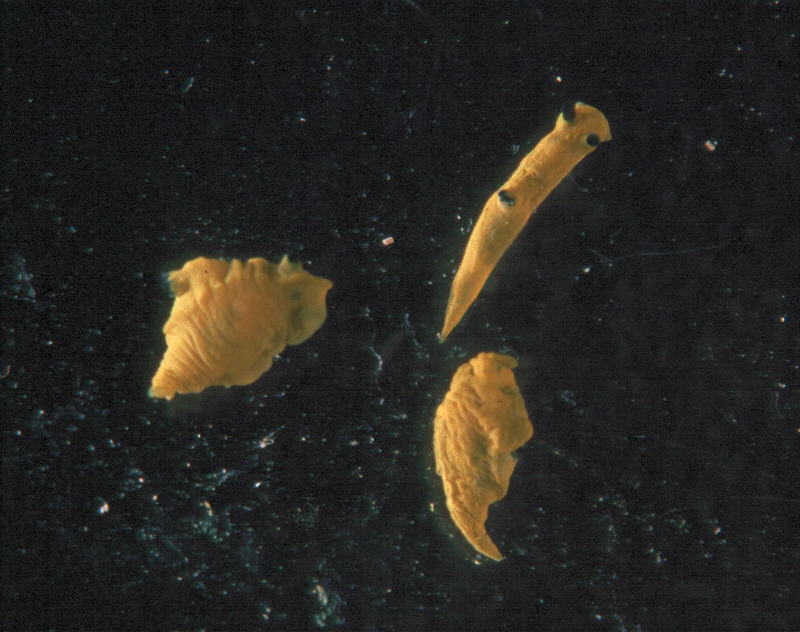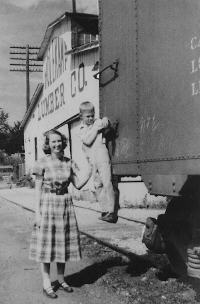 |
Tambja oliva
Tambja oliva Meyer, 1977
Hace multos años, tuve yo la oportunidad de estudiar los opistobránquios de Panamá, bajo el patrocimiento de una beca. Para mí, era un gran honor, y aprendí mucho en Panamá, trabajando con Kani Meyer.
Nearly 30 years ago (August 1974), while I was still a Ph.D. candidate at the University of California Berkeley, I received a grant to study at the Smithsonian Tropical Research Institute in Panama. This was a very special honor to me, because in addition to the opportunity to study the opisthobranch fauna of both coasts of Panama , I was able to work with, and learn from, Dr. Kaniaulono B. Meyer . I worked at the Galeta Point marine station of STRI, in front of which was a magnificent reef that exposed numerous rollable-rocks at low tide.
This was an exciting month for a young graduate student, whose previous out-of-country experiences had been limited (or expanded!) to México. Not only did I have the chance to snorkel and work low tides on both the Atlantic and Caribbean coastlines of Panama, I was also able to see some of the human culture and land organisms.
We visited El Castillo de San Lorenzo , which had begun construction in 1597. All its cannons were to naught, when the English pirate Henry Morgan captured the fort in 1671. So much for that! The area has always been a thorn in the side of numerous nations, because it represents the quickest way across the Americas from the Atlantic to the Pacific. It sure beats rounding the Horn and sinking in the horrendous waves and winds!!! However, it should be remembered how many native people and Caribbean workers died during the construction of the Panama Canal.
The streets of Panama City (on the Pacific coast) are a mixture of modern and old. At night from the hotel where I stayed the first night of my arrival, I had a magnificent view of the bustling economy of high-rises of Panama City . And then during the day we visited some of the older districts of Panama City . They have a distinctive faux nouveau architecture, reminiscent of New Orleans and the (former) French company town of Santa Rosalía in Baja California Sur.
I was especially intrigued by being able to see the local sloths in their environment. The two-toed sloth ] has only two claws (toes) on its forefeet. It is also nearly meticulously groomed. In contrast, the three-toed sloth (count them) is remarkably slothful, and actually has algae growing in its fur . So, in nudibranch parlance, I guess we have slow, slower, and slowest!
Well, with that as an introduction, now let me get to the current Nudibranch of the Week: Tambja oliva Meyer, 1977.
The introductory photograph to this BOW is the first published photo of the species; in her 1977 article, Kani published only a line drawing of the living animal, and a SEM of the radula that I gave her.
Probably the simplest way to explain this quite rare species, is to use Kani's original description:
"Body higher than wide, smooth, laterally compressed; head rounded or truncated; tail pointed; notal ridge reduced, extending around head, along sides of body, meeting in a point a short distance behind gills; oral veil reduced to two shallow, cup-like indentations; 4-5 pinnate gills; 14-16 rhinophore leaves extending nearly to sheath; sheath edge smooth; color deep olive green to light green or olive yellow oven with microscopic flecks of yellow, blue or turquoise; tips of gills, tail, oral tentacles light to dark purple or blue-green; rhinophores often purple or white with opaque cream spots; labial cuticle smooth; radula formula 12-13 (4.1.1.1.4); rachidian plate dark, undivided, broader than high, with a smooth rounded anterior edge; lateral tooth bicuspid, second cusp well developed but smaller than main cusp; marginal teeth rectangular, 4 in number, becoming progressively smaller distally; ampulla dividing just before entering the female gland mass giving off a narrow duct which enlarges slightly forming the intercalary prostate; male duct narrowing at half its length to become the vas deferens; vas deferens bearing bulbous based hooks; male duct entering the fundus of the atrium; spermatheca and spermatocyst separated; spermatheca with a short vagina leading off the atrium near the opening of the female gland mass and insemination duct; gland of undetermined function connected to spermatocyst by a short duct but lacking sperm; sperm present in spermatocyst, spermatheca, and ampulla; uterine duct discrete; ducts from spermatocyst, vagina, and female gland mass open close to each other; female gland mass covered by a black net externally; remainder of hermaphroditic glands pale."
Her original description included two figures: a line drawing of the living animal, and my scanning electron micrograph of a portion of the radular teeth. In this BOW, we present the first photograph (and in color!) of this species (see introductory photograph), and additional SEMs of the radular teeth.
Attached to this BOW are three photos of the radula of Tambja oliva Meyer, 1977. The first is an overall view of the radula. The second SEM (which had been published in the original description of the species) shows the first lateral tooth and marginal teeth of the species. The third SEM that I took, is a close-up of just the lateral teeth.
The specimen from which I had extracted the radula and made the SEMs was collected by Kani Meyer on 25 August 1974, subtidally, at Galeta Reef. It was one of 5 specimens she had collected that day. These specimens had not been reported by Kani in her original description. I have since deposited these animals in the collections of the Los Angeles County Museum of Natural History. To my knowledge, the only known occurrence of these animals is in the area of the Galeta Marine Laboratory, at Galeta Point (9E 24' 18" N; 79E 51' 48" W).
I am especially grateful to the opportunity that I had to study with Kani at the Galeta STRI marine lab "hace muchos años" (a long time ago!!!).
Reference
Meyer, Kaniaulono B. 1977. Dorid nudibranchs of the Caribbean coast of the Panama Canal Zone. Bulletin of Marine Science 27 (2): 299-307.
Imperial Beach, Calif
April, 2004
Taxonomic Information and Photos
courtesy of Dr. Hans Bertsch

You can drop Hans a note at hansmarvida@cox.net
|
